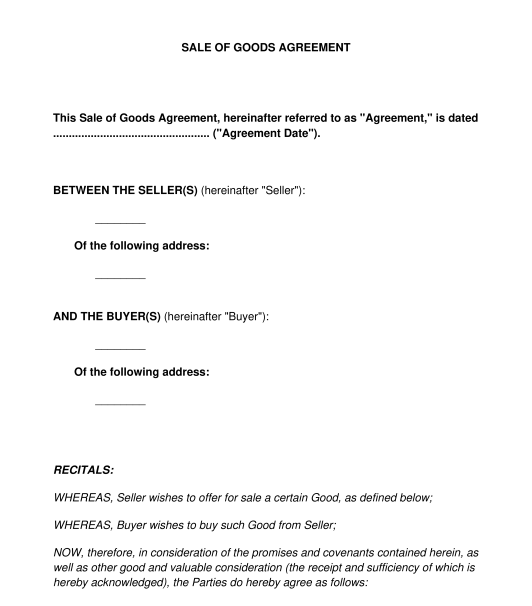 21/01/2024
21/01/2024

Answer a few questions and your document is created automatically.

Your document is ready! You will receive it in Word and PDF formats. You will be able to modify it.




Rating: 4.2 - 17 votes
Fill out the templateA Sale of Goods Agreement, also sometimes called a Sales Agreement or Sales Contract, is a document that a buyer and seller can enter when a certain good or certain goods are being sold. Through a Sale of Goods Agreement, a seller and buyer can outline the terms and conditions of the sale of the item or items being transferred. A Sale of Goods Agreement contains provisions about the basic logistics of the sale, like price and delivery information, but also contains the information required for an equitable relationship between the parties, such as risk of loss.
A Sale of Goods Agreement can cover the sale of any type of good, whether it's a one-time sale or multiple shipments over time. However, this contract is not designed for use in real estate transactions.
Because the transfer of goods is at issue and because money is changing hands, it can be a good idea to have all the details of the parties' understanding contained in one written agreement. Doing so also avoids any misunderstandings between the parties and can help to prevent disputes down the track.
Although a Sales Agreement can be as detailed or as general as required by the parties, it is a best practice to include pertinent information about the transfer of title, as well as broader legal clauses covering what may happen in case of a dispute. Having a well-written Sale of Goods Agreement can help protect one or both of the parties in case there is a problem with the sale.
This Sale of Goods Agreement is sometimes confused with a Bill of Sale. The two documents look quite similar, but serve different purposes. This Sale of Goods Agreement is generally signed and exchanged between the parties ahead of time. By signing the document, the parties are agreeing that on some future date, the buyer will pay the agreed price for the goods, and the seller will hand the goods over to the buyer.
Alternatively, a Bill of Sale is generally handed over at the time that the goods actually become the property of the buyer (for example, when the buyer receives the goods). The Bill of Sale serves as a proof of purchase for the buyer, and confirms that the buyer has actually paid for the goods, and is now the owner of the goods.
We have a template Bill of Sale available. Alternatively, if a vehicle is being sold (at some future date), use our Vehicle Sale Agreement.
The Australian Government provides a lot of guidance about consumer contracts, covering such matters as consumer guarantees and unfair contract terms, on its Australian Consumer Law website.
How to use this document
This document can be used by a seller getting ready to enter into a relationship with a new buyer, or by a buyer looking to purchase some goods from a seller. In this document, the parties will be able to enter pertinent identifying details, such as whether the parties are individuals or businesses, and their respective addresses and contact information. It is also possible to input the most important characteristics of the agreement between the parties, like a description of the goods, pricing, delivery information, transfer of ownership, warranties and risk of loss.
Once the document has been prepared and before it is signed, it can be reviewed by the parties so that they can check that their details are correct and can make sure that they are happy with the various terms.
Both parties may then sign the document. If the parties are individual persons, they may have their signatures witnessed by independent adult witnesses (they should not witness each other). If either party is a company, then they may need to consider section 127(1) of the Corporations Act 2001, which specifies how a company must sign an Agreement. Failure to comply with that legislation may mean that this Agreement is not legally binding.
Importantly, if the Australian Consumer Law applies, and if seller is providing any warranties against defects in relation to the goods, then the Australian Consumer Law requires these warranties to be presented in a certain way, and to include certain information. There are penalties for failure to do this. If in doubt, seek legal advice.
Both parties should then keep a copy of the document for their own records.
Applicable law
Sale of Goods Agreements in Australia are subject to general principles of contract law.
If goods are being sold to the public, then the Australian Consumer Law which is set out in the Competition and Consumer Act 2010 (Commonwealth), may also be relevant.
Each state and territory of Australia has a version of a Sale of Goods Act, which may also apply.
How to modify the template
You fill out a form. The document is created before your eyes as you respond to the questions.
At the end, you receive it in Word and PDF formats. You can modify it and reuse it.
Guides to help you
Other names for the document:
Agreement for Sale, Agreement for Sale of Goods, Agreement for Sales, Agreement for the Sale of Goods, Agreement to Sell Goods
Country: Australia